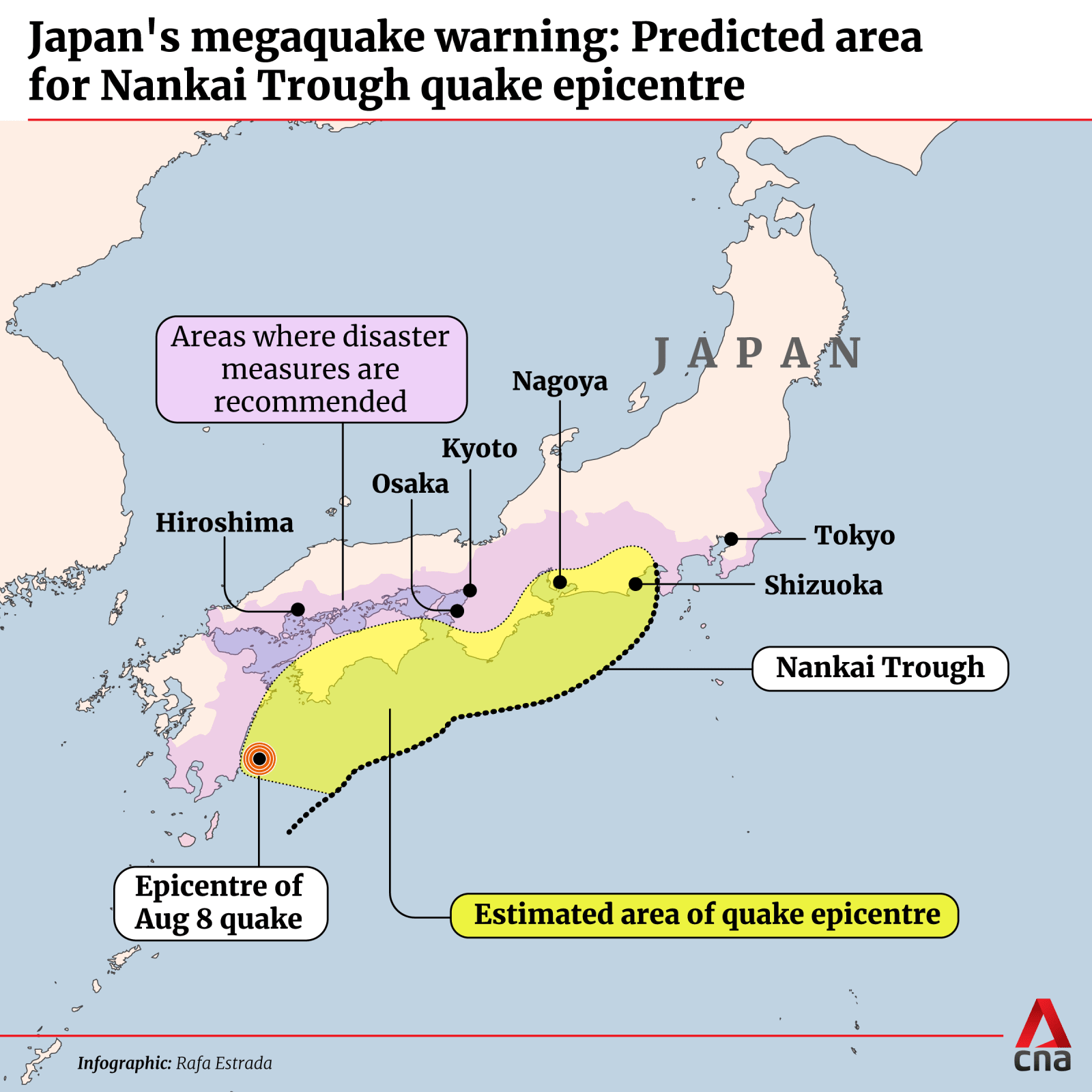Commentary: Japan is living in the shadow of the megaquake
The warning of a tremor that could kill more than 320,000 people is forcing Japan to think of the abstract danger of disaster in more concrete terms, says Gearoid Reidy for Bloomberg Opinion.

A house is seen collapsed in Oosaki town, Kagoshima prefecture, southern Japan on Aug 9, 2024, following a powerful earthquake. (File photo: AP/Kyodo News)
TOKYO: To live in Japan is to live with the risk of a devastating earthquake at any time.
Usually, however, people tend to view that threat in the abstract. It’s kind of like thinking about death - I know I’ll die someday, but I hope it won’t be today. And so far, at least, I keep getting lucky.
Until we don’t. Thursday’s announcement from Japanese authorities, warning of an increased risk of a long-feared megaquake, forced citizens to consider the very real and immediate danger of an event that would devastate the country and upend life as we know it.
Following a 7.1 magnitude tremor off Kyushu, the country’s weather agency issued for the first time ever a warning that the likelihood of the long-feared Nankai Trough quake had increased “by several times”.
The fault, stretching some 900km down Japan’s Pacific coast from Shizuoka to Shikoku, is feared for a reason. It has caused temblors of magnitude 8 or more, accompanied by devastating tsunamis, around every 100 to 150 years.
The country has repeatedly warned that another is imminent, with estimates of a 60 per cent probability of it hitting in the next 20 years, and 90 per cent in the next 40 years. Now, authorities are saying that peril has become even higher.
People were unsure how to react. What does “relatively higher” risk mean? Should we change our plans? Was this a warning, or a prediction?
HARD TO OVERSTATE THE RISK
The risk of the Nankai Trough earthquake occurring is debatable. But the risk from such an event is hard to overstate.
When it comes to dreaded earthquakes in Japan, this is the Big One. Much of the country would experience shaking as hard as any quake here ever caused. Tsunami waves of 10 meters or more could arrive within minutes. Government modelling has put the number of dead at up to 320,000, although recent estimates have reduced this number by about 30 per cent.
The country could sustain an 11 per cent hit to gross domestic product, with some 220 trillion yen (US$1.5 trillion) of damage - one estimate from the Japan Society of Civil Engineers put the total economic impact over 20 years at nearly six times that.
Nearly 10 per cent of the population might have to be evacuated. And this is before we get into any impact on nuclear plants, the supposed “unforeseeable” risk of the 2011 disaster that triggered meltdowns in Fukushima.
These are not numbers we’re used to seeing in a developed country, certainly not one as prepared for disaster as Japan. That’s why the government has long sought to forecast the event and minimise the damage.
Earthquake prediction itself is a fool’s errand; while some quakes in Japan have been preceded by foreshocks, such as that which hit two days before Mar 11, 2011, authorities note that this happens only once in every several hundred cases.
But because of the nature of the Nankai Trough quakes, some experts believe that the omens of a disaster can be seen. A quake in one part of the fault is often followed by another, though that pairing can occur within 32 hours as in 1854, or up to two years later as seen in 1944 and 1946, the last time the fault caused a major tremor.

NO ONE KNOWS IF IT’S TIME TO PANIC
Compounding the confusion is the fact that the alert comes just as Japanese prepare to take off en masse for Obon, the unofficial summer holiday period when city dwellers typically return to their hometowns.
It’s another looming but incorporeal threat in a country that in the last week has faced the possibility of higher mortgage rates for the first time in over a decade, and a market crash and rebound that few have ever experienced
There will be plenty to talk about with relatives around the dinner table. Thoughts will return to the last major earthquake, which struck on New Year’s Day this January just as people were napping off holiday food comas.
No one quite knows if it’s time to panic just yet. For some, it was a good reminder to check on the status of emergency supplies and equipment. Others reacted with humour, with one wit online noting that since Google Maps allows reviews for the Nankai Trough, we should placate it with a series of five-star reviews.
Others still, like Robert Geller, professor emeritus at the University of Tokyo, believe any prediction is a waste of time, and distracts authorities from preparing for earthquakes that can’t be anticipated - a category into which all the country’s recent devastating disasters, from Kobe to 2011, have fallen.
One more serious risk is that of the boy who cried wolf. This alert is shocking; if nothing happens, will a future warning be ignored, even though the real danger might have dramatically increased? I am reminded of attitudes to a less natural threat - the North Korean missiles that sometimes fly over the country - which once stopped traffic and now tend to elicit yawns.
In all likelihood, the megaquake will not happen this time, and this episode will be forgotten. But for all the time we spend thinking of slow-moving problems - exercising to cut the risk of heart disease, reducing carbon emissions to curb climate change, creating a nest egg to weather that next recession - the alert is a reminder that nature doesn’t move to such timelines.
For residents in Japan, it’s a good opportunity to do what we can to be prepared and check evacuation routes. And for all of us, it’s a moment to think about the fragility of the world we’ve built, and how quickly it can be upended.















